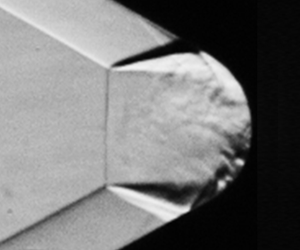Crossref Citations
This article has been cited by the following publications. This list is generated based on data provided by
Crossref.
Wang, Ziao
Xin, Xuanan
Huang, Renzhe
Kong, Chen
Lv, Chengkun
and
Chang, Juntao
2022.
Mechanism of shock-train/boundary-layer interaction in spanwise concave isolator channels.
Acta Astronautica,
Vol. 199,
Issue. ,
p.
232.
Liu, Sijia
Kang, Dake
Yan, Chao
Sun, Mao
and
Jiang, Zhenhua
2022.
Passive Flow Control for Heat Flux Reduction on V-Shaped Blunt Leading Edges.
p.
108.
Wang, Ziao
Xin, Xuanan
Chen, Ruoyu
Huang, Renzhe
Kong, Chen
and
Chang, Juntao
2023.
Development and evolution mechanism of streamwise vortex in an inward-turning inlet.
Proceedings of the Institution of Mechanical Engineers, Part G: Journal of Aerospace Engineering,
Vol. 237,
Issue. 15,
p.
3413.
Zhang, Tao
Cheng, Jianrui
Shi, Chongguang
Zhu, Chengxiang
and
You, Yancheng
2023.
Mach reflection of three-dimensional curved shock waves on V-shaped blunt leading edges.
Journal of Fluid Mechanics,
Vol. 975,
Issue. ,
Li, Shuai
Yan, Chao
Kang, Dake
Liu, Sijia
and
Jiang, Zhenhua
2023.
Investigation of flow control methods for reducing heat flux on a V-shaped blunt leading edge under real gas effects.
Physics of Fluids,
Vol. 35,
Issue. 3,
Liu, Sijia
Yan, Chao
Kang, Dake
Jiang, Zhenhua
and
Sun, Mao
2023.
Opposing jets for heat flux reduction and uncertainty analysis on a V-shaped blunt leading edge.
Aerospace Science and Technology,
Vol. 138,
Issue. ,
p.
108353.
Kang, Dake
Yan, Chao
Liu, Sijia
Wang, Zhaowei
and
Jiang, Zhenhua
2023.
Modelling and shock control for a V-shaped blunt leading edge.
Journal of Fluid Mechanics,
Vol. 968,
Issue. ,
Zhong, Jiaxiang
Qu, Feng
Sun, Di
Liu, Qingsong
Wang, Qing
and
Bai, Junqiang
2024.
Low-frequency unsteadiness mechanisms of unstart flow in an inlet with rectangular-to-elliptical shape transition under off-design condition at a Mach number of 4.
Journal of Fluid Mechanics,
Vol. 991,
Issue. ,
Li, Shenghan
Kang, Dake
Li, Shuai
Yan, Chao
and
Jiang, Zhenhua
2024.
Analytical mechanisms for heat flux reduction on a V-shaped blunt leading edge.
Physics of Fluids,
Vol. 36,
Issue. 8,
Li, Shuai
Jiang, Zhen-hua
Kang, Da-ke
Yin, Tong
and
Yan, Chao
2024.
Investigation of the heat flux reduction scheme on a V-shaped blunt leading edge based on secondary recirculation jets.
Acta Astronautica,
Vol. 215,
Issue. ,
p.
1.
Wang, Liyao
Yang, Li
Wu, Wannan
Chen, Jifeng
Jia, Lichao
Zhai, Zhigang
and
Yue, Lianjie
2025.
Shock reflection with the influence of wave structures near the intersection point in confined-space double-wedge.
Aerospace Science and Technology,
p.
110266.
Xie, Wei
Luo, Zhenbing
Liu, Qiang
Zhou, Yan
Ding, Zhenwei
and
Wang, Yunan
2025.
Shock/shock interaction type transition control for drag and heat reduction by opposing jet in high-speed flow.
Energy,
Vol. 324,
Issue. ,
p.
136056.
Li, Dengke
Sun, Bo
Dai, Chunliang
Chen, Xiong
and
Man, Yanjin
2025.
Thermo-chemical non-equilibrium flows and aerodynamic loads of Type III shock/shock interaction on blunted lip of a Mach 12 inlet.
Aerospace Science and Technology,
Vol. 161,
Issue. ,
p.
110168.
Yang, Jing
Cui, Kai
Tian, Zhong Wei
Li, Guang Li
Xiao, Yao
and
Chang, Siyuan
2025.
Type I to type II transition in swept-forward fin shock interactions.
Physics of Fluids,
Vol. 37,
Issue. 2,
Yang, Jing
Li, Guangli
Chang, Siyuan
Tian, Zhongwei
Xiao, Yao
and
Cui, Kai
2025.
Numerical investigation of sideslip angle effects on swept-forward fin shock interactions.
Proceedings of the Institution of Mechanical Engineers, Part G: Journal of Aerospace Engineering,
Zhang, Tao
Rao, Luoyu
Zhang, Xuhui
Shi, Chongguang
Zhu, Chengxiang
and
You, Yancheng
2025.
Heating reduction with shock control for a V-shaped blunt leading edge.
Journal of Fluid Mechanics,
Vol. 1002,
Issue. ,
ZHANG, Tao
ZHANG, Xuhui
RAO, Luoyu
SHI, Chongguang
ZHU, Chengxiang
and
YOU, Yancheng
2025.
Mach reflection and pressure/heating loads on V-shaped blunt leading edges with variable cross-sections and crotches.
Chinese Journal of Aeronautics,
Vol. 38,
Issue. 1,
p.
103163.

 $R/r$ (i.e. the crotch radius
$R/r$ (i.e. the crotch radius  $R$ over the leading edge radius
$R$ over the leading edge radius  $r$) and
$r$) and  $\beta$ (i.e. the half-span angle between the two straight branches), including regular reflection (RR), Mach reflection (MR) and regular reflection from the same family (sRR). These wave structures are observed in shock tunnel experiments and are reproduced by numerical simulations. Of great interest, transitions of shock interactions from RR to MR and from MR to sRR are identified with variation in
$\beta$ (i.e. the half-span angle between the two straight branches), including regular reflection (RR), Mach reflection (MR) and regular reflection from the same family (sRR). These wave structures are observed in shock tunnel experiments and are reproduced by numerical simulations. Of great interest, transitions of shock interactions from RR to MR and from MR to sRR are identified with variation in  $R/r$ or
$R/r$ or  $\beta$. It is revealed that the specific geometric constraints of VBLEs, rather than the classic detachment and von Neumann criteria, govern the transitions of shock interactions. From theoretical analyses of the relative geometric positions of the shock structures near the crotch, transition criteria of the shock interactions on VBLEs are established. These theoretical transition criteria achieve good agreement with the numerical and experimental results for a wide range of
$\beta$. It is revealed that the specific geometric constraints of VBLEs, rather than the classic detachment and von Neumann criteria, govern the transitions of shock interactions. From theoretical analyses of the relative geometric positions of the shock structures near the crotch, transition criteria of the shock interactions on VBLEs are established. These theoretical transition criteria achieve good agreement with the numerical and experimental results for a wide range of  $R/r$ and
$R/r$ and  $\beta$ and thus show great potential for practical engineering applications, such as the selection of geometric parameters for the cowl lip of a hypersonic inlet.
$\beta$ and thus show great potential for practical engineering applications, such as the selection of geometric parameters for the cowl lip of a hypersonic inlet.